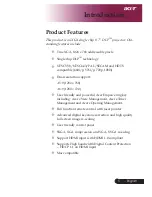
Connection 23
• Transmission speed and image quality will vary according to the
bandwidth of local area network and the status of network usage.
To connect the projector to a notebook or desktop computer
(using HDMI):
1.
Take a HDMI cable and connect one end to the HDMI jack of the computer.
2.
Connect the other end of the cable to the HDMI jack on the projector.
• Many notebooks do not turn on their external video ports when
connected to a projector. Usually a key combo like FN + F3 or CRT/
LCD key turns the external display on/off. Locate a function key labeled
CRT/LCD or a function key with a monitor symbol on the notebook.
Press FN and the labeled function key simultaneously. Refer to your
notebook's documentation to find your notebook's key combination.
Connecting a monitor
If you want to view your presentation close-up on a monitor as well as on the screen,
you can connect the MONITOR OUT signal output jack on the projector to an
external monitor following the instructions below:
To connect the projector to a monitor:
1.
Connect the projector to a computer as described in
"Connecting a computer"
on page 22
.
2.
Take a suitable VGA cable (only one supplied) and connect one end of the cable
to the D-Sub input jack of the video monitor.
Or if your monitor is equipped with a DVI input jack, take a VGA to DVI-A cable
and connect the DVI end of the cable to the DVI input jack of the video monitor.
3.
Connect the other end of the cable to the MONITOR OUT jack on the
projector.
• The output signal for MONITOR OUT jack only works when the input
signal comes from COMPUTER IN-1 or COMPUTER IN-2 jack. When
the projector is powered on, the output signal from MONITOR OUT
jack varies depending on the input signal from COMPUTER IN-1 or
COMPUTER IN-2 jack.
• If you wish to use this connection method when the projector is in
standby mode, make sure the MONITOR OUT function is turned on in
the SYSTEM SETUP: Advanced > Standby Settings menu. See
"Standby Settings" on page 63
for details.
















































